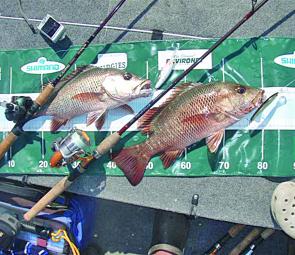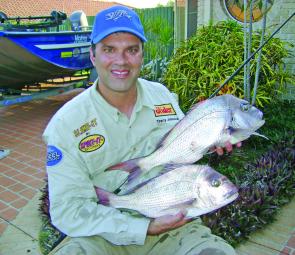Things have started to heat up around the Southern Bay area – for both climate and fishing. Bream, snapper, flathead and whiting are all very common at this time of the year. And spotted mackerel, mack tuna and longtail tuna are also on their way in.
Further down among the Islands, there are some good mangrove jacks to be caught. Watch for days when the hot northerlies really turn the temperatures up, this seems to turn the fish on. These really are a fantastic fish to catch; they hit like a freight train and don’t stop until they are either back in their lair or in the boat.
A combination of skill, strong tackle and a little luck is required to land jacks regularly. Rock bars are by far the most consistent place to find a mangrove jack, despite their name, but any undercut banks with mangrove roots and fallen timber are worth fishing too. Some areas to look include Macleay Island, Eprapah Creek, rockbars around The Powerlines, Canaipa Passage and Cobby Passage. Depending on the depths, some spots will fish better at the top or the bottom of the tide but generally there has to be some run in the water to get the fish feeding aggressively. Popular techniques include drifting live poddy mullet under a float, slow hopping soft plastics and twitching diving minnow lures over the shallow rocky areas.
No matter which method you use, it is important to keep the bait or lure close to the rocks and reef the fish inhabit as the fish won’t often travel far to hit a bait or lure. The odd snag is pretty much inevitable but likewise if you don’t cast close enough then you will normally go fishless. Jack fishing tackle is very much on the heavy side as far as estuary gear goes. Twenty pound mono or braid would be considered light, 30lb is the norm and occasionally 40 or 50lb gear is necessary in some nightmare spots. When fishing in daylight hours, mid afternoon when the heat is at it’s most intense, through to dark is most popular. At night, jacks will feed very well and will fall to all the popular techniques. Sometimes the fish will come out of their holes and hunt in open water in search of prey, however, this tends to happen in the small hours of the morning after all the boat traffic has died down. At this time it can sometimes be possible to use much lighter lines than normal and fairly unconventional jack lures, such as poppers. Some of the more popular jack lures around the Southern Bay area include Lively Lure Mad Mullets, Lucky Craft Bevy Shads and Smith Cherry Bloods.
There have been good numbers of school mackerel working the Rainbow Channel and around the top end of Peel Island. By mid November there should be some tunas and spotty mackerel mixed in with them as well. While there is no obvious surface action going on, the most productive way to chase the mackerel is to float gang-hooked pilchards down a burley trail or slow troll a spoon lure rigged with a paravane to get it down deep. Once the activity begins to boil over on the surface, then stalking the fish with metal lures, soft plastics and fly, becomes the most fun way to fish.
Sand whiting are another very active fish in spring. Any sand or mud bank around the Southern Bay Islands and foreshores will hold a population of these tasty critters, but for the big ‘elbow slappers’ look for the deeper channels and gutters adjacent to the flats. Popular baits include worms, yabbies and prawns rigged on small hooks like a #4 long shank and light 4-6lb line. Lure fishing for whiting has not been the most successful fishing method, but in recent times some keen anglers have had excellent results using small surface poppers over shallow sand and weed beds.
Until next month, tight lines! If you want more info drop into see us at Fish Head. Our big brand new store is opening in Victoria Pt in early November. We are off the Redland Bay Rd between Supercheap Auto and the Woolworths Servo, right next to Patton Butchers.
Reads: 6247
Double hookup on Jacks. One is on a Lively Lures Mad Mullet and the other is on a Smith Cherry Blood.

Tracy Johnson with a couple of good bay squire.

Frank Waite caught this 90cm snapper on a 5” Nuclear Chicken Gulp.




